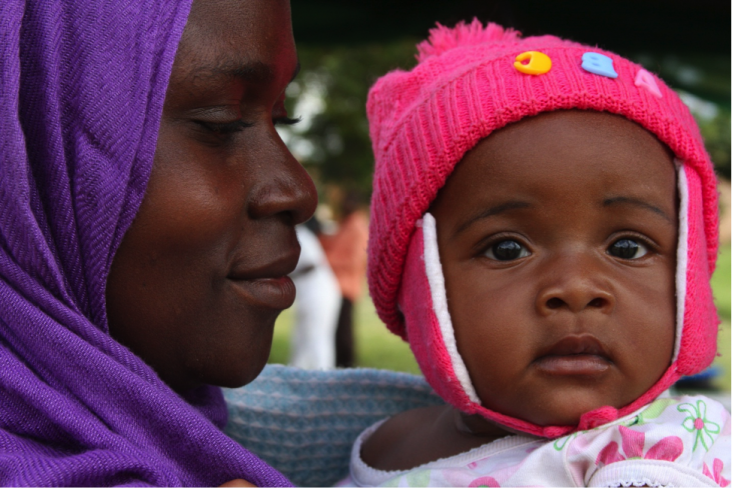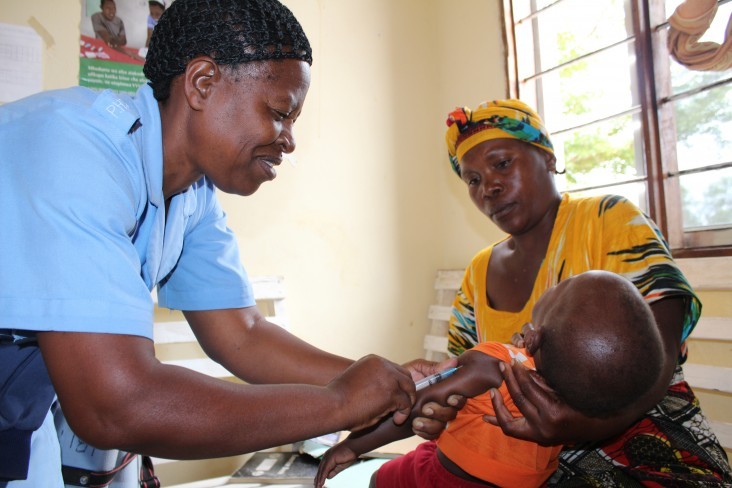Speeches Shim

USAID Maternal and Child Health Investments, FY16: $13,135,000
Tanzania Quick Facts: Immunization
70 percent reduction in child mortality rate, 1990-20151
75 percent reduction in number of unvaccinated children in target regions in a single year (2015-2016)2
97 percent of children nationally receiving second dose of rotavirus vaccine, 20143
One morning in Urambo District, a mother brought in her 9-month-old daughter to the Vumilia Dispensary, a local health clinic.. Tecra Chubwa, the nurse who oversees the facility, remembers the toddler and her mother, and even remembers weighing the girl herself. But when she later reviewed the day’s vaccination records, she discovered the child had not received the measles-rubella vaccine that she was due for on that day.
Tecra, however, was not deterred. She and a community health worker at her facility consulted records where they keep health information on all of the children in the village, including details about the parents, the hamlets in which they live, and the names and contact information of the local community leaders. After examining the map of houses and paths that is kept at her facility, Tecra turned to the community health worker who was assisting in the search.
“Let’s go to the village and find this child,” Tecra said, and the two set out to ensure that the girl received her vaccination.
In Tanzania, the U.S. Agency for International Development (USAID) is working with the Ministry of Health and Social Welfare (MOHSW) and Council Health Management Teams (CHMTs) to expand access to lifesaving vaccines in three regions that have disproportionately high rates of under- and unvaccinated children.
Through this initiative, USAID has helped train nearly 500 health providers, including Tecra, in more than 400 health facilities in the three target regions on how to collect, plot, interpret and utilize health data. Health providers are able to use this information to assess the performance of facility immunization programs and to modify outreach and activity plans based on their findings.
“Unlike in the past, we are now sitting together as a team to review our performance and order supplies before stocks run out,” said Tecra. USAID has additionally helped train more than 800 community health workers who work alongside health providers to improve immunization services, expand outreach activities, educate parents on the importance of immunization, and identify and trace children who are due for their next vaccinations to ensure that they receive them.
Tecra and the community health worker at her side put their training to good use. They found the mother and her daughter, who were back at Vumilia Dispensary two days later.
“When I asked the mother why she left early the other day, she said she thought they were done,” recalled Tecra. “‘I had only brought my child to be weighed, that was all I wanted,’ she had said, totally unaware the child needed to be vaccinated.
Tecra promptly gave the infant girl the measles-rubella vaccine that she had missed and counselled her mother on the importance of vaccines. The mother returned to her village with a daughter protected against two deadly diseases and with a new understanding of the importance of immunization for her child’s health.

A HEALTHY START FOR EVERY CHILD
Over the past fifteen years, the child mortality rate in Tanzania has been reduced by 63 percent, falling from 131 infant deaths per 1,000 live births in 2000 to 49 deaths per 1,000 live births in 2015.4 USAID has contributed to that success through the U.S. Government’s investment of more than $250 million since 2000 for maternal and child health in Tanzania.
Today, despite high rates of vaccination coverage across Tanzania, certain regions have disproportionately high numbers of under- and unvaccinated children. USAID is working to improve immunization services in three poorer-performing districts that together account for 40 percent of all under- and unvaccinated children in the country.
Through pre-service training and curriculum improvement, USAID is building Tanzania’s capacity to deploy more effective immunization services in the future so that the health sector and its workers can better serve all Tanzanians. By investing in the immunization systems of countries such as Tanzania, USAID invests in stronger and more resilient health systems for the future. Our efforts in Tanzania and other USAID priority countries for maternal and child health are saving lives today, and at the same time helping to build a safer, healthier and more prosperous tomorrow.
FROM INVESTMENT TO IMPACT
USAID’s efforts are helping to keep children safe from vaccine preventable diseases. In the 2014 Acting on the Call Report, USAID formulated a roadmap for making data-driven decisions and targeted investments to save the lives of 15 million children and 600,000 women by 2020.5 In Tanzania, scaling up high impact practices could save the lives of 460,000 children under-5 by 2020.6
By improving the health of women and children in countries like Tanzania, USAID invests in the wellbeing of communities and societies around the globe. USAID and our partners are advancing American security and prosperity in an increasingly globalized world.
Meet more of the women and children that benefit from USAID's efforts.
« Back to the Acting on the Call home page
1 Levels and Trends in Child Mortality: Report 2015. UNICEF, September 2015.
2 2017 Acting on the Call Report
3 Immunization and Vaccine Development (IVD) program data, 2014. Unpublished.
4 Levels and Trends in Child Mortality: Report 2015. UNICEF, September 2015.
5 Acting on the Call: Ending Preventable Child and Maternal Deaths. USAID, June 2014.
6 Acting on the Call: Ending Preventable Child and Maternal Deaths. USAID, June 2015.

Comment
Make a general inquiry or suggest an improvement.